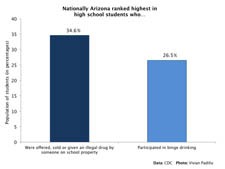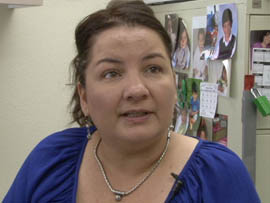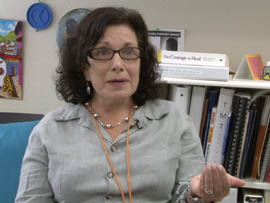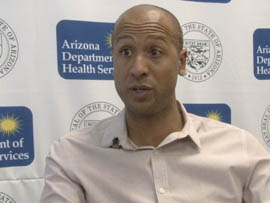Cronkite News has moved to a new home at cronkitenews.azpbs.org. Use this site to search archives from 2011 to May 2015. You can search the new site for current stories.
Arizona worst or close in CDC measures of teen substance abuse
PHOENIX – When administrators at Camelback High School suspect a substance abuse problem, they refer students to Monica Meza or Suzan Patalano, school employees who act as facilitators for Teen Addiction Anonymous.
The voluntary program helps students kick drug and alcohol abuse and other destructive behaviors.
“The beauty of this group is people have to want to be in it, and it’s not a punishment,” said Patalano, a clinical social worker at the school. “It’s a support.”
Used by 20 Valley high schools, Teen AA is one way officials are addressing rates of teenage substance abuse that ranked Arizona near the bottom among states in a report by the U.S. Centers for Disease Control and Prevention.
The 2011 Youth Risk Behavior Surveillance report, covering various dimensions of substance abuse, ranked Arizona as having the nation’s highest rate (34.6 percent) of high schoolers who were offered, sold or given an illegal drug by someone on school property. Arizona also had the highest rate of binge drinking at 26.5 percent.
Arizona’s youth ranked second in five other categories: those who had ever used cocaine; those who currently used cocaine; those who tried marijuana for the first time before age 13; those who currently drank alcohol; and those who had consumed alcohol on school property.
Jean Ajaime, who collected Arizona’s survey data for the CDC as the Arizona Department of Education’s director of school safety and prevention, said the results weren’t surprising.
“We’ve been aware that substances are widely available on our campuses,” she said.
Ajaime said Arizona needs to focus more attention on threats to the health, safety and academic success of students.
“We have a need for more resources on campus, such as support personnel, because they are key in prevention and intervention,” she said.
Laura Bosworth, professor and Smith Endowed Chair in Substance Abuse Education at the University of Arizona, said Arizona’s ranking in the CDC report reflects the broader population’s attitudes on drug and alcohol use.
“It’s a part of society, and it’s a part of growing up and being cool,” she said. “Substance use has become a part of adolescents. It is a time of experimentation, and most people who start drinking and smoking start during high school.”
Jason Bowers, senior prevention coordinator with the Arizona Department of Health Services’ Division of Behavioral Health Services, said Arizona’s rates of drug and alcohol use have actually declined in recent years.
The 2012 Arizona Youth Survey, produced by the Arizona Criminal Justice Commission, found a decrease since 2008 in students who reported ever having used alcohol or cocaine or having engaged in binge drinking. However, marijuana use increased during that period.
Bowers said state health officials focus on educating parents and school administrators about prevention.
“Parents are the first line of defense; they are the individuals who have the most contact with their child, and teachers as well,” he said.
Through dozens of coalitions across the state, Bowers’ office works to mobilize the community against substance abuse and educate young people about the dangers.
“We live in a country that has deemed substance use as a community norm,” he said. “I feel it’s my responsibility in the Office of Prevention to provide facts to youth and to let them know the statistics that are out there, and the fact that they could be possibly a statistic.”
At Camelback High School, students taking part in Teen AA have met every Thursday for past two years. Monica Meza, a bilingual counselor at the school, said the goal is creating an environment for recovery.
“When they find that group that is going through the same or similar situation, they find hope and they realize they are not alone,” Meza said.
Fellow facilitator Suzan Patalano said that while measuring success is difficult she knows the program changes lives.
“We plant a lot of seeds, and we never know exactly when they’re going to blossom, but they do,” she said.











